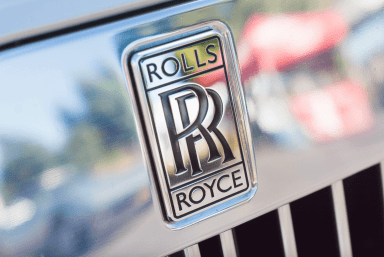Rolls-royce Company profile
Discover Rolls Royce share price today with our interactive streaming chart.
Rolls-Royce is a world-renowned brand commonly associated with luxury and high-quality engineering. Although the automobile brand and manufacturing was sold to BMW and Volkswagen respectively, Rolls-Royce Holdings plc continues to manufacture a large proportion of the world’s civic and military propulsion systems. It is a market leader in these industries, with its subsidiaries operating around the globe.
The Rolls-Royce business is varied and far reaching:
-
Civil Aerospace – Rolls-Royce makes the Trent 900 engine, of which four are used on the Airbus A380, the world’s largest passenger airliner. It also provides the Trent 100 for the Boeing 787, a popular-mid range aircraft.
-
Defence Aerospace – It makes engines for the British Hercules C-130, a transport aircraft. It also powers the Tornado Typhoon and the Eurofighter Typhoon, both top-of-the-line multirole fighter jets.
-
Power Systems – The main focus here is on small-scale energy generation, such as diesel gensets for emergency, or peak usage, applications. The Oil & Gas division was acquired by Siemens in 2014.
-
Marine – The portfolio includes many engines for both civil and military purposes, such as for Turkish boat builder ARES, the Royal Navy’s new Type 26 Global Combat Ship and exploration of futuristic electric naval ships.
-
Nuclear – One of the main products is the nuclear propulsion system for British Astute class submarines. However it also produces small modular reactors and a variety of services in maintaining active reactors.
-
R2 Data Labs – The data division of Rolls-Royce. This acts as a development hub both internally and externally.
Rolls-Royce stock trading
Rolls-Royce stock trades under the symbol RR on the London Stock Exchange (LSE), and is a constituent of the FTSE 100 index. The company has a current market capitalisation of £5.245bn.
In 2020, the Rolls Royce share value has been shaken after Covid-19 wiped out over 90 per cent of the demand for air travel due to worldwide lockdown measures.
As many aerospace companies and aircraft manufacturers use Rolls-Royce jet engines, the RR stock has been in distress lately, as demand has evaporated.
RR shares nosedived on March 3, 2020, losing 56 per cent of its value by May 22 and trading at around £280 per share. The Rolls-Royce share price chart has not seen such a low price level since 2009 during the financial crisis.
In order to survive until the crisis is over, Rolls Royce has announced a far-reaching reorganisation plan aiming to “strengthen the financial resilience” of the company’s business. The effectiveness of this latest reorganisation remains to be seen.
Keep an eye on the latest Rolls-Royce share price with Capital.com. Check out our live chart and follow all the ups and downs of the Rolls-Royce shares today to spot the best points to enter or exit a trade on Rolls-Royce stock.
Rolls-Royce history
Rolls-Royce was started by Henry Royce in 1884 as an electrical and mechanical business. The first Rolls-Royce was built in 1904 after Royce met Charles Rolls, who sold luxury cars in a London showroom.
The brand was catapulted onto centre stage with the launch of the six-cylinder Silver Ghost in 1906, which rapidly became known as one of the best cars in the world. In 1914 the company produced its first aero engine – the Eagle.
1931 saw the development of a new engine – the “R”, which powered the British entry in the International Schneider Trophy race. The plane established a new world air speed record of over 400 mph. The R was the technological base of the Merlin, the engine that powered the Hawker Hurricane, and Supermarine Spitfire, stalwarts of the RAF during the Second World War.
Rolls Royce entered the civil aviation market in 1953 with the Dart engine for the Vickers Viscount, one of the first gas turbines in the airline industry.
In 1973 the automobile part of the business was floated as a separate entity after the company was taken into state ownership. Through several mergers and acquisitions the company expanded into providing engines for air, sea and land travel.
In 1990 a joint venture was made with BMW Germany to make aero engines; in 1995 the Allison Engine Company was acquired to produce a new engine for Embraer’s new regional jet. In 1998 Rolls-Royce Motor Cars was sold by Vickers to VW, although BMW holds the naming rights on Rolls-Royce cars.
Latest shares articles
